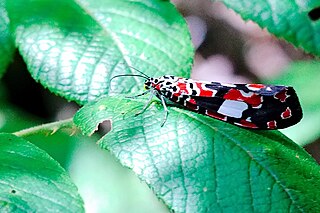
Crotalaria is a genus of flowering plants in the family Fabaceae commonly known as rattlepods. The genus includes over 700 species of herbaceous plants and shrubs. Africa is the continent with the majority of Crotalaria species, which are mainly found in damp grassland, especially in floodplains, depressions and along edges of swamps and rivers, but also in deciduous bush land, roadsides and fields. Some species of Crotalaria are grown as ornamentals. The common name rattlepod or rattlebox is derived from the fact that the seeds become loose in the pod as they mature, and rattle when the pod is shaken. The name derives from the Ancient Greek κρόταλον, meaning "castanet", and is the same root as the name for the rattlesnakes (Crotalus).

Utetheisa is a genus of tiger moths in the family Erebidae. The genus was first described by Jacob Hübner in 1819.

The Arctiini are a tribe of tiger moths in the family Erebidae.

Pyrrolizidine alkaloids (PAs), sometimes referred to as necine bases, are a group of naturally occurring alkaloids based on the structure of pyrrolizidine. Pyrrolizidine alkaloids are produced by plants as a defense mechanism against insect herbivores. More than 660 PAs and PA N-oxides have been identified in over 6,000 plants, and about half of them exhibit hepatotoxicity. They are found frequently in plants in the Boraginaceae, Asteraceae, Orchidaceae and Fabaceae families; less frequently in the Convolvulaceae and Poaceae, and in at least one species in the Lamiaceae. It has been estimated that 3% of the world’s flowering plants contain pyrrolizidine alkaloids. Honey can contain pyrrolizidine alkaloids, as can grains, milk, offal and eggs. To date (2011), there is no international regulation of PAs in food, unlike those for herbs and medicines.

Gnathothlibus erotus, the white-brow hawkmoth, is a moth of the family Sphingidae. The species was first described by Pieter Cramer in 1777.
Rattlepod is a common name for several plants and may refer to:

Utetheisa pulchelloides, the heliotrope moth, is a moth of the family Erebidae. It is found in the Indo-Australian region including Borneo, Hong Kong, New Zealand, Papua, Seychelles, most of Australia,Tenerife and La Línea de la Concepción [Cádiz]. The species was first described by George Hampson in 1907.

Utetheisa ornatrix, also called the ornate bella moth, ornate moth, bella moth or rattlebox moth, is a moth of the subfamily Arctiinae. It is aposematically colored ranging from pink, red, orange and yellow to white coloration with black markings arranged in varying patterns on its wings. It has a wingspan of 33–46 mm. Moths reside in temperate midwestern and eastern North America as well as throughout Mexico and other parts of Central America. Unlike most moths, the bella moth is diurnal. Formerly, the bella moth or beautiful utetheisa of temperate eastern North America was separated as Utetheisa bella. Now it is united with the bella moth in Utetheisa ornatrix.

Eudocima is a genus of moths of the family Erebidae with numerous tropical species. The genus was first categorised by Gustaf Johan Billberg in 1820, and species currently in the genus have been placed under a range of other genera in the past. Adult moths in the genus are known for puncturing and feeding on the juices of fruits, because of which they are considered as pests by horticulturists.

Eudocima salaminia, the green fruit-piercing moth, is a moth of the family Erebidae. The species was first described by Pieter Cramer in 1777. It is found from India, and across south-east Asia to the Pacific Islands. In Australia it occurs in the Northern Territory, Queensland and New South Wales. The adult is a fruit piercer.

Argina astrea, the crotalaria podborer, is a moth of the family Erebidae. The species was first described by Dru Drury in 1773. It is found in eastern Africa, southern Asia of India, Sri Lanka, Maldives and Indo-Australia, including the Pacific Islands and Australia.

Cephonodes picus is a moth of the family Sphingidae described by Pieter Cramer in 1777. It is found in most of the Old World tropics, including India, the Cocos-Keeling Islands, the Maldives, Papua New Guinea, the Philippines, the Torres Strait Islands, Brunei and the Chagos Archipelago.

Utetheisa elata is a moth in the family Erebidae. It was described by Johan Christian Fabricius in 1798. It is found in Angola, South Africa and Tanzania, as well as on the Comoros, Réunion, Madagascar, Mauritius and the Seychelles.














